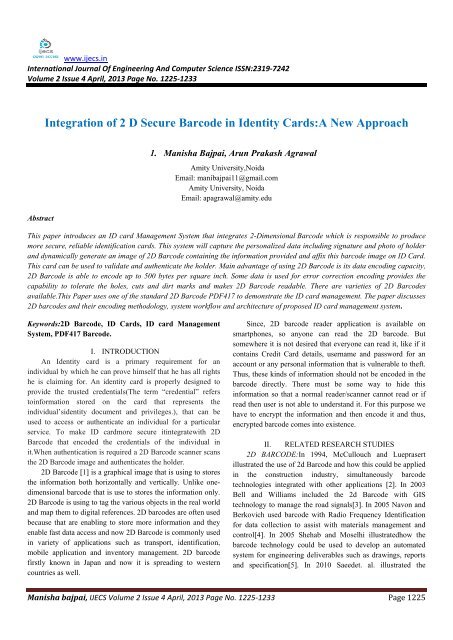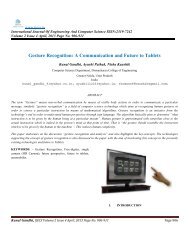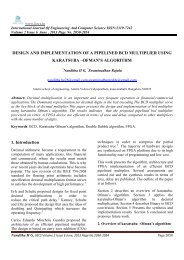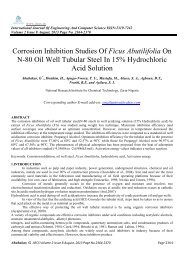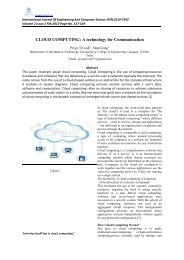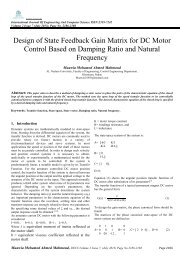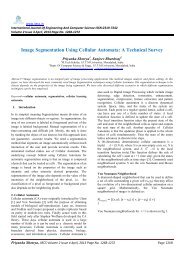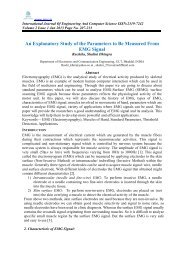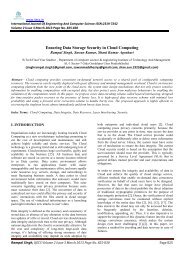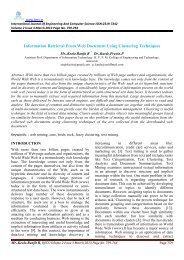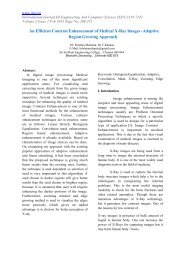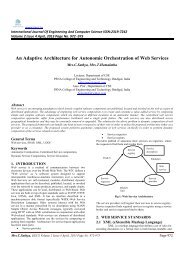Integration of 2 D Secure Barcode in Identity Cards:A New ... - Ijecs
Integration of 2 D Secure Barcode in Identity Cards:A New ... - Ijecs
Integration of 2 D Secure Barcode in Identity Cards:A New ... - Ijecs
You also want an ePaper? Increase the reach of your titles
YUMPU automatically turns print PDFs into web optimized ePapers that Google loves.
www.ijecs.<strong>in</strong>International Journal Of Eng<strong>in</strong>eer<strong>in</strong>g And Computer Science ISSN:2319-7242Volume 2 Issue 4 April, 2013 Page No. 1225-1233<strong>Integration</strong> <strong>of</strong> 2 D <strong>Secure</strong> <strong>Barcode</strong> <strong>in</strong> <strong>Identity</strong> <strong>Cards</strong>:A <strong>New</strong> ApproachAbstract1. Manisha Bajpai, Arun Prakash AgrawalAmity University,NoidaEmail: manibajpai11@gmail.comAmity University, NoidaEmail: apagrawal@amity.eduThis paper <strong>in</strong>troduces an ID card Management System that <strong>in</strong>tegrates 2-Dimensional <strong>Barcode</strong> which is responsible to producemore secure, reliable identification cards. This system will capture the personalized data <strong>in</strong>clud<strong>in</strong>g signature and photo <strong>of</strong> holderand dynamically generate an image <strong>of</strong> 2D <strong>Barcode</strong> conta<strong>in</strong><strong>in</strong>g the <strong>in</strong>formation provided and affix this barcode image on ID Card.This card can be used to validate and authenticate the holder. Ma<strong>in</strong> advantage <strong>of</strong> us<strong>in</strong>g 2D <strong>Barcode</strong> is its data encod<strong>in</strong>g capacity,2D <strong>Barcode</strong> is able to encode up to 500 bytes per square <strong>in</strong>ch. Some data is used for error correction encod<strong>in</strong>g provides thecapability to tolerate the holes, cuts and dirt marks and makes 2D <strong>Barcode</strong> readable. There are varieties <strong>of</strong> 2D <strong>Barcode</strong>savailable.This Paper uses one <strong>of</strong> the standard 2D <strong>Barcode</strong> PDF417 to demonstrate the ID card management. The paper discusses2D barcodes and their encod<strong>in</strong>g methodology, system workflow and architecture <strong>of</strong> proposed ID card management system.Keywords:2D <strong>Barcode</strong>, ID <strong>Cards</strong>, ID card ManagementSystem, PDF417 <strong>Barcode</strong>.I. INTRODUCTIONAn <strong>Identity</strong> card is a primary requirement for an<strong>in</strong>dividual by which he can prove himself that he has all rightshe is claim<strong>in</strong>g for. An identity card is properly designed toprovide the trusted credentials(The term “credential” refersto<strong>in</strong>formation stored on the card that represents the<strong>in</strong>dividual’sidentity document and privileges.), that can beused to access or authenticate an <strong>in</strong>dividual for a particularservice. To make ID cardmore secure it<strong>in</strong>tegratewith 2D<strong>Barcode</strong> that encoded the credentials <strong>of</strong> the <strong>in</strong>dividual <strong>in</strong>it.When authentication is required a 2D <strong>Barcode</strong> scanner scansthe 2D <strong>Barcode</strong> image and authenticates the holder.2D <strong>Barcode</strong> [1] is a graphical image that is us<strong>in</strong>g to storesthe <strong>in</strong>formation both horizontally and vertically. Unlike onedimensionalbarcode that is use to stores the <strong>in</strong>formation only.2D <strong>Barcode</strong> is us<strong>in</strong>g to tag the various objects <strong>in</strong> the real worldand map them to digital references. 2D barcodes are <strong>of</strong>ten usedbecause that are enabl<strong>in</strong>g to store more <strong>in</strong>formation and theyenable fast data access and now 2D <strong>Barcode</strong> is commonly used<strong>in</strong> variety <strong>of</strong> applications such as transport, identification,mobile application and <strong>in</strong>ventory management. 2D barcodefirstly known <strong>in</strong> Japan and now it is spread<strong>in</strong>g to westerncountries as well.S<strong>in</strong>ce, 2D barcode reader application is available onsmartphones, so anyone can read the 2D barcode. Butsomewhere it is not desired that everyone can read it, like if itconta<strong>in</strong>s Credit Card details, username and password for anaccount or any personal <strong>in</strong>formation that is vulnerable to theft.Thus, these k<strong>in</strong>ds <strong>of</strong> <strong>in</strong>formation should not be encoded <strong>in</strong> thebarcode directly. There must be some way to hide this<strong>in</strong>formation so that a normal reader/scanner cannot read or ifread then user is not able to understand it. For this purpose wehave to encrypt the <strong>in</strong>formation and then encode it and thus,encrypted barcode comes <strong>in</strong>to existence.II. RELATED RESEARCH STUDIES2D BARCODE:In 1994, McCullouch and Lueprasertillustrated the use <strong>of</strong> 2d <strong>Barcode</strong> and how this could be applied<strong>in</strong> the construction <strong>in</strong>dustry, simultaneously barcodetechnologies <strong>in</strong>tegrated with other applications [2]. In 2003Bell and Williams <strong>in</strong>cluded the 2d <strong>Barcode</strong> with GIStechnology to manage the road signals[3]. In 2005 Navon andBerkovich used barcode with Radio Frequency Identificationfor data collection to assist with materials management andcontrol[4]. In 2005 Shehab and Moselhi illustratedhow thebarcode technology could be used to develop an automatedsystem for eng<strong>in</strong>eer<strong>in</strong>g deliverables such as draw<strong>in</strong>gs, reportsand specification[5]. In 2010 Saeedet. al. illustrated theManisha bajpai, IJECS Volume 2 Issue 4 April, 2013 Page No. 1225-1233 Page 1225
<strong>in</strong>tegration <strong>of</strong> 2d <strong>Barcode</strong>, GPS and RFID to provide thesolution for pedestrian users access<strong>in</strong>g <strong>in</strong>formation[6].After the terrorist attacks on 11 September 2001[7],aproposal <strong>of</strong> ID cards becomes an Entitlement cards after therevived by the home secretary at the time David Blunkett. Butit was opposed by Cab<strong>in</strong>etcolleagues. As the identity concernissue like identity theft and the misuse <strong>of</strong> public service <strong>in</strong>February 2002 <strong>in</strong>creased, the proposed entitlement cards to beused to get the Social security services and consultant papers.A.<strong>Identity</strong> cardsA document which is used to verify the person's personalidentity called <strong>Identity</strong> document. ID document may be issued<strong>in</strong> form <strong>of</strong> small and standard-sized card; it is usually called anidentity card(IC). A card identify data about a person, as name,age, hair color, etc. and <strong>of</strong>ten bear<strong>in</strong>g a photograph.Some countries do not have their formal identity card sothey may require <strong>in</strong>formal documents like driv<strong>in</strong>g license andpassport. Earlier India also comes <strong>in</strong> the country that doesn'thave their formal identity cards, to prove the personalidentification driv<strong>in</strong>g license or passport requires but now <strong>in</strong>India also issues a formal <strong>Identity</strong> card named "AADHAR".obta<strong>in</strong> the credit and services <strong>in</strong> the name <strong>of</strong> the victim ormade a thief with false credentials.Type <strong>of</strong> <strong>Identity</strong> Theft• <strong>Identity</strong> clon<strong>in</strong>g and concealment• Crim<strong>in</strong>al identity theft• Synthetic identity theft• Medical identity theft• Child identity theftIII. BASIC OF BARCODESA barcode represents data about the object to which it isattached such that only mach<strong>in</strong>e can read. <strong>Barcode</strong>s are <strong>of</strong>three types- one-dimensional (1D), two-dimensional (2D) andthree-dimensional (3D). In 1D barcode, data is represented byvary<strong>in</strong>g the widths and spac<strong>in</strong>g <strong>of</strong> parallel l<strong>in</strong>es, whereas <strong>in</strong> 2Dbarcode <strong>in</strong>formation is stored both horizontally and vertically.3D barcodes do not use any barcode labels. They are embossedor engraved directly on the product dur<strong>in</strong>g manufactur<strong>in</strong>gprocess.B. Types <strong>of</strong> <strong>Identity</strong> CardIn the absence <strong>of</strong> formal <strong>Identity</strong> card there are numerousmethods to identify an <strong>in</strong>dividual. Today there are verities <strong>of</strong>identity documents and ID cards are available with the latesttechnologies such as biometrics, holographic image, specialover lam<strong>in</strong>ation process and more. ID cards are becom<strong>in</strong>gmore effective for users and makers alike.• Birth certificates-A document that give the <strong>in</strong>formationabout the birth date and place, also it is used to identityparents name <strong>of</strong> an <strong>in</strong>dividual.• Social Security ID cards - A Social Security cards isneeded for verification and identification <strong>of</strong> an <strong>in</strong>dividual.• Passports - Passport is an <strong>of</strong>ficial government documentthat certifies one's identity and citizenship and permit totravel abroad. Without this travel<strong>in</strong>g aboard is an illegal<strong>of</strong>fence.• Driver's licenses - Driver's licenses are issued by thegovernment <strong>of</strong> countries to identify that <strong>in</strong>dividual havedriv<strong>in</strong>g privileges or not. It also used for many otherpurposes.• Other ID cards -Schools and universities also provide IDcards to students, but these are almost universally used foron-campus purposes and activities.C.<strong>Identity</strong> Theft<strong>Identity</strong> theft is a k<strong>in</strong>d <strong>of</strong> crime <strong>in</strong> which an imposter getthe personal <strong>in</strong>formation <strong>of</strong> someone such as Social securitynumber, driv<strong>in</strong>g licence number <strong>in</strong> order to pretends someoneelse. This <strong>in</strong>formation can be used to access the resources or(a) 1D <strong>Barcode</strong>(b) 2D <strong>Barcode</strong>Figure 1: <strong>Barcode</strong>sIn general, there are two types <strong>of</strong> 2D barcodes: stacked 2Dbarcodes, such as Code 49 and PDF417, and Matrix 2Dbarcodes, such as Data Matrix and QR Code. 1D barcodesdepend upon database for the object’s description to which it isattached, where we can store the complete description <strong>of</strong> theobject <strong>in</strong> the 2D barcodes.<strong>Barcode</strong>s are scanned by special optical scanners calledbarcode readers and now-a-days s<strong>of</strong>tware become available ondevices <strong>in</strong>clud<strong>in</strong>g smartphones, so that anyone carry<strong>in</strong>g mobilephone with barcode scanner s<strong>of</strong>tware can read the barcodes.We can use Smartphone to capture, store and display thebarcodes. We can store our card details <strong>in</strong> 2D barcode, whichcan be useful for payment through our smartphones. We canalso store username and password with url <strong>in</strong> 2D barcode toaccess our mail account by just scann<strong>in</strong>g it throughsmartphone.Manisha bajpai, IJECS Volume 2 Issue 4 April, 2013 Page No. 1225-1233 Page 1226
A.TYPES OF 2D BARCODES AND ENCODINGMETHODOLOGY1)QR BARCODE:QR Code [8] is a 2-dimenstional barcode<strong>in</strong>vented by the Japanese corporation Denso-Wave <strong>in</strong> 1994.The prefix QR stands for Quick Response, as the code that canbe decoded at high-speed [9]. QR Code support Kanjiencod<strong>in</strong>g that the reason for its popularity <strong>in</strong> mobile tagg<strong>in</strong>gapplications. QR code is most popular <strong>in</strong> Japan.The Size <strong>of</strong> QR barcode symbol depends on the<strong>in</strong>formation to be encoded. Symbol version def<strong>in</strong>ed <strong>in</strong> therange <strong>of</strong> 1 to 40. Each version has different moduleconfiguration (the module refers to the black and white dots <strong>of</strong>QR code). Version 1 size is 21 x 21 modules and as version<strong>in</strong>crement by 1 module size <strong>in</strong>crement by 4 x 4. e.g. version 1module size is 21 x 21, version 2 module size is 25 x 25,version 3 module size is 29 x 29....version 40 module size is177 x 177 modules.1.1.3.To Create the QR Code and data encod<strong>in</strong>g it uses theReed Solomon code algorithm. RS Code parameters areshown <strong>in</strong> parentheses2)DATA MATRIX: Data Matrix is a form <strong>of</strong> 2D barcode withhigh data density. That able to encodes text or row data <strong>in</strong> apattern <strong>of</strong> black and white square modules. Data size <strong>of</strong> datamatrix is maximum up to 2 kbs. The symbols can be readableeven if they are partially damaged by <strong>in</strong>clud<strong>in</strong>g errorcorrection codes accord<strong>in</strong>g to ECC200 standard.The length <strong>of</strong> encoded data depends up on the number <strong>of</strong>cells <strong>in</strong> the matrix.Figure 3:Data MatrixFigure 2: QR CodeThere are four modes:• Numeric mode• Alphanumeric mode• 8-bit byte mode• Kanji and kana characters mode.The comb<strong>in</strong>ations <strong>of</strong> these modes are also possible.QR code has <strong>in</strong>-built error correction based on ReedSolomon algorithms. Error correction level def<strong>in</strong>ed thereadability percentage <strong>of</strong> damaged code. The QR code has fourerror correction levels 7%, 15%, 25% and 30% per symbol.1.1)QR CODING METHOD: The QR encod<strong>in</strong>g method worksas follows:1.1.1. QR code uses a smallest number <strong>of</strong> cod<strong>in</strong>gcapability to store the QR code and error correction level,<strong>in</strong> consideration the total cod<strong>in</strong>g capability <strong>of</strong> data<strong>in</strong>formation.2.1) DATA MATRIX DATA CAPACITY: A Data Matrixbarcode can hold upto 3116 digits, 2335 alphanumericcharacters or 1556 bytes, barcode’s capacity depends up on thestructure <strong>of</strong> data to be encoded, Data capacity also affected bythe available pr<strong>in</strong>t<strong>in</strong>g space and pr<strong>in</strong>ter resolution.2.2) DATA MATRIX ENCODING: The encod<strong>in</strong>g process isdescribed <strong>in</strong> documents published by ISO website [10]. Opensource s<strong>of</strong>tware for encod<strong>in</strong>g and decod<strong>in</strong>g the ECC-200variant <strong>of</strong> Data Matrix has been published [11].The diagrams below illustrate the how a message dataplaced with<strong>in</strong> a Data Matrix symbol. Message data arranged <strong>in</strong>a complicated diagonal pattern, start from the upper-leftcorner. In diagonal pattern some characters are split <strong>in</strong> twopieces like as <strong>in</strong>itial W, and "I" is <strong>in</strong> "corner pattern 2" <strong>in</strong>stead<strong>of</strong> usual L-shaped arrangement. Also as shown below omitsome other bytes like end <strong>of</strong> message code (marked End), P(padd<strong>in</strong>g), E (error correction) bytes and X (unused space).Multiple encod<strong>in</strong>g modes used to store k<strong>in</strong>ds <strong>of</strong> messages.By default mode to stores one ASCII character per 8 bitcodewords.1.1.2. Maximum number <strong>of</strong> cod<strong>in</strong>g characters <strong>in</strong> eachmode is as follows.• Numeric mode: 7089 characters• Alphanumeric mode: 4296 characters• 8-bit byte mode: 2953 characters• Kanji and kana character mode: 1817 charactersManisha bajpai, IJECS Volume 2 Issue 4 April, 2013 Page No. 1225-1233 Page 1227
Figure 4: Encod<strong>in</strong>g Data MatrixTEXT MODES C40, Text and X12 modes codes are packed<strong>in</strong>to two bytes. These codes are probably more compact forstor<strong>in</strong>g the text messages. These are use character codes <strong>in</strong> therange 0-39. V = C1*1600 + C2*40 + C3 + 1B1 = floor (V/256)B2 = V mod 256Result<strong>in</strong>g value <strong>of</strong> B1 is <strong>in</strong> the range 0-249.EDIFACT MODEEDIFACTmode uses three bytes <strong>of</strong> fourcharacters and per character is six bits. It can store digits,upper-case letters and punctuation marks. It does not supportlower-case letters.BASE 256 Mode: Base 256 mode data starts from the length<strong>in</strong>dicator, followed by a number <strong>of</strong> data bytes. 1 to 249characters can be encoded <strong>in</strong> to a s<strong>in</strong>gle byte and longerlengths are stored <strong>in</strong>to two bytes.L1 = floor(length / 250) + 249,L2 = length mod 250The length and data bytes are confused by add<strong>in</strong>g apseudorandom value R (n), where n is the position <strong>in</strong> the bytestream.R (n) = (149 × n) mod 255 + 13)PDF417: PDF417 is high-capacity two-dimensionalbarcodes. it is capable to store up to 2710 data characters. It isa stacked l<strong>in</strong>er barcode symbol is extensively used for examplewith <strong>in</strong> aviation, automobile <strong>in</strong>dustry, identification,transportation and <strong>in</strong>ventory management. It was orig<strong>in</strong>allypublished by Symbol technologies, Inc. But later it become asISO standard. Here PDF is for Portable Data File and 417describes the structure that how a s<strong>in</strong>gle data character isencoded 4 bars and 4 spaces <strong>in</strong> a 17 units wide.3.1) PDF417 DATA CAPACITY: PDF417 is high data densitybarcode. PDF417 is a row based barcode. It consists with amaximum <strong>of</strong> 90 rows and 30 columns. The maximum number<strong>of</strong> data is depend<strong>in</strong>g on the compaction mode used, the number<strong>of</strong> columns and rows and the error correction level. Themaximum data size is dependent on both the compaction modeas well as <strong>in</strong>put data.1. 2710 digits <strong>in</strong> numeric compaction mode2. 1850 characters <strong>in</strong> text compaction mode3. 1108 bytes <strong>in</strong> byte compaction modeA barcode can hold up to maximum <strong>of</strong> 929 codewords.3.2) PDF417ENCODINGSYMBOL STRUCTURE:PDF417symbology is also called a "stacked l<strong>in</strong>ear symbology" becausea s<strong>in</strong>gle PDF417 symbol can be imag<strong>in</strong>ed as multiple l<strong>in</strong>earbarcodes stacked above each other. And a row is consists <strong>of</strong>maximum 90 rows and 30 columns. The shape <strong>of</strong> a PDF417 isrectangular. Figure shows the detail structure <strong>of</strong> PDF417.• Quiet zone• Startpattern• Left row <strong>in</strong>dicator symbol characters• 1 - 30 data symbol characters• Right row <strong>in</strong>dicator symbol characters• Stop pattern• Trail<strong>in</strong>g quiet zoneFigure 5: PDF417[12]Data region <strong>of</strong> each row is bounded by the left and rightrow <strong>in</strong>dicators that provide the follow<strong>in</strong>g <strong>in</strong>formation:• row number• number <strong>of</strong> rows (3 - 90)• number <strong>of</strong> columns <strong>in</strong> the data region (1 - 30)• error correction level (0 - 8)SYMBOL DIMENSIONSThe size <strong>of</strong> a PDF417 barcode[13] can be calculatedus<strong>in</strong>g the follow<strong>in</strong>g formula:Width = ((17 * # <strong>of</strong> columns) + 69) X + 2 (size <strong>of</strong> quiet zone)Height = (# <strong>of</strong> rows) (row height) + 2 (size <strong>of</strong> quiet zone)ERROR DETECTION AND CORRECTIONError correction mode is used to detect and correct theerrors <strong>in</strong> PDF417 barcode. Each PDF417 have a user def<strong>in</strong>edcorrection level. Upto 510 additional error correctioncodewords can be added to the end <strong>of</strong> payload data formaximum data correction and each barcode has a m<strong>in</strong>imum 2error detection codewords. The Reed Solomon [14] errorcontrol code algorithm is used to compute the error correctioncodewords. Two types <strong>of</strong> errors that can address the errorcorrection:1. Rejection errors - In this type <strong>of</strong> error miss<strong>in</strong>g, unscannedand undecodable symbol character come whose position areknown but value are not known.2. Substitution errors - In this type <strong>of</strong> error miss<strong>in</strong>g,unscanned and undecodable symbol character come whoseposition or values both are unknown.Here is the formula to determ<strong>in</strong>e the error correctioncapacity <strong>of</strong> PDF417# Of erasures + 2(# <strong>of</strong> errors) = # <strong>of</strong> error correction codewords -2Table shown below provides the error correction levels basedup on the amount <strong>of</strong> data codewords <strong>in</strong> PDF417.Manisha bajpai, IJECS Volume 2 Issue 4 April, 2013 Page No. 1225-1233 Page 1228
# <strong>of</strong> DataCodewords1 – 4041 - 160161-320321 – 863Error CorrectionLevel2345B.SYSTEM WORKFLOWFigure 7: Architecture1) BASIC CONCEPTS: For implement<strong>in</strong>g the identitycard management system, uses two processed first one isrecord<strong>in</strong>g process and the second one is authentication process.TRANSMITTED DATATable 1: Error Correction LevelsTransmission <strong>of</strong> data <strong>in</strong> PDF417 is depends upon thecompaction modes that are used. All other symbol start, stop,row <strong>in</strong>dicators, symbol length descriptor, mode switchcharacters and error correction are not transmitted.IV. SECURE IDENTIFICATION SYSTEMSecurity is the ma<strong>in</strong> concern <strong>in</strong> the identification system,In our research we created a new <strong>in</strong>novative 2D <strong>Barcode</strong> basedID Card system. That can be used to authenticate holder's<strong>in</strong>formation when they required. System <strong>in</strong>tegrates 2D <strong>Barcode</strong>that encode the user personal <strong>in</strong>formation <strong>in</strong> encrypted format.RECORDING PROCESS:In this process, the systemconsist<strong>in</strong>g with a centralized database with <strong>Identity</strong> cardmanagement system that will take the <strong>in</strong>puts <strong>of</strong> the <strong>in</strong>formationgiven by the person and will issue an identity card with 2Dbarcode affixed on it.AUTHENTICATION PROCESS:In this process, systemauthenticates the holder that he/she is a genu<strong>in</strong>e one. A 2D<strong>Barcode</strong> scanner scans the image affixed on the ID Card andwill send this image to centralized server for cross verificationwith the image already stored <strong>in</strong> database. If a relevant matchfound, then the person is genu<strong>in</strong>e one.A. SYSTEM INFRASTRUCTURE AND FRAMEWORKARCHI-TECTURE• CLIENT LAYER - This layer <strong>in</strong>cludes a user <strong>in</strong>terface to<strong>in</strong>teract with users and perform user account andmembership that uses for Input Holder's <strong>in</strong>formation andmanagement.• APPLICATION LAYER - This layer will <strong>in</strong>clude the 2D<strong>Barcode</strong> based security and bus<strong>in</strong>ess logics.• DATA STORE LAYER -This is the ma<strong>in</strong> layer <strong>of</strong> systemthat <strong>in</strong>cludes a centralized database for stor<strong>in</strong>g, ma<strong>in</strong>ta<strong>in</strong><strong>in</strong>gand process<strong>in</strong>g the Holder's account such as Name, PhotoID, signature etc.Client Layer(User Interface’s to capture Holder’sInformation, card issue. Etc.)Application Layer(2D <strong>Barcode</strong>, Bus<strong>in</strong>ess Logics, .Net)Data Store Layer(Store the Holder’s Information)2) BASIC STEPS FOLLOWED:1. AnAuthenticated person will get holder’s <strong>in</strong>formation andfill the key form manually and submit the form andforward the new application for verification to Adm<strong>in</strong>department.2. Next after the verification for the registered requestreceived by the first step. Adm<strong>in</strong> will check and validatethat entered <strong>in</strong>formation and given documents are validthen he will forward it for card issue.3. In this step a new <strong>in</strong>terface that will issue a card with 2D<strong>Barcode</strong> affixed for respective request.4. Whenever a person needs to be identified, the scann<strong>in</strong>gmach<strong>in</strong>e extracts the holder’s <strong>in</strong>formation from barcodeand matches with <strong>in</strong>formation stored <strong>in</strong> the central database<strong>of</strong> the organization.5. If scanned barcode <strong>in</strong>formation and stored <strong>in</strong>formation aresame then the person is genu<strong>in</strong>e and he allowaccess<strong>in</strong>g theservices where authentication is required otherwise not.6. If verification fails, he/she has to report to authority, so thatnecessary action can be taken. The verification failurehappens ma<strong>in</strong>ly when the barcode is tampered.7. If 2D <strong>Barcode</strong> is tempered or lost then person has to reportto Adm<strong>in</strong> for the re-generation <strong>of</strong> card.8. For regeneration request adm<strong>in</strong> has to follow step-2 and 3for the reissue cards.Manisha bajpai, IJECS Volume 2 Issue 4 April, 2013 Page No. 1225-1233 Page 1229
B) PHOTO: This form is used to <strong>in</strong>put the holder’sphoto andC) signature.2) IDENTIFICATION FORM: This form basicallyprovides the identification facility <strong>of</strong> the holder. It requiresbarcode on the form as <strong>in</strong>put. It extracts the Reg. No. from thebarcode and match with the all holders <strong>in</strong> database and returnsall subsequent matches and shows the full holder’s<strong>in</strong>formation. This form is used by the Adm<strong>in</strong> department for3) identify the holder.V. IMPLEMENTATION STEPSWe implemented this approach us<strong>in</strong>g “C# language"onVisual Studio 2010 with.Net Framework 4.0 <strong>in</strong>stalled on a PCrunn<strong>in</strong>g W<strong>in</strong>dows 7 hav<strong>in</strong>g Core i3 2.27 GHzprocessor and320 GB <strong>of</strong> ma<strong>in</strong> memory.The implementation consists <strong>of</strong>: Enrollment Form,Identification Form, Verification Form, Card Issue Form,Log<strong>in</strong> Form, Change Password Form andMaster Forms.Master Forms are used serves the purpose <strong>of</strong> chang<strong>in</strong>gmasterpassword.4) VERIFICATION FORM: This form provides theverification facility <strong>of</strong> the holder. It takes barcode on the formas <strong>in</strong>put and extract the Reg. No. and other <strong>in</strong>formation fromthe barcode and verify it with the <strong>in</strong>formation stored <strong>in</strong> thedatabase and shows the holder’s <strong>in</strong>formation.This form is usedwhen holder needs to be verified.5) CARD ISSUE: This form is used to issue card to theholder. It has three panels search panel, list panel and previewVI. DETAILS OF SCREEN SHOTS1) ENROLLEMENT FORM: This form is used to enrollthe holder <strong>in</strong> organization. In this form an authenticated personenter the holder’s full <strong>in</strong>formation. This form has follow<strong>in</strong>gthree sub forms:A) BIOMATRIC DATA: This form is used to <strong>in</strong>put all thebasic <strong>in</strong>formation about holder such as personal detail, birthdetail, communication detail and identification detail.panel. Search panel have some field for f<strong>in</strong>d<strong>in</strong>g the recordfrom the database and resulted record will show <strong>in</strong> list paneland <strong>in</strong> the preview panel it show the identity card’s preview <strong>of</strong>selected records from list panel. It shows the preview <strong>of</strong> cardfrom both side front and back side <strong>of</strong> identity card, identitycard has the holder’s photo, name, reg. No. and authorizedsignature <strong>in</strong> front side, and contact address, signature andbarcode <strong>in</strong> back side. This panel also has a pr<strong>in</strong>t button to pr<strong>in</strong>tthe card <strong>in</strong> pr<strong>in</strong>ter.Manisha bajpai, IJECS Volume 2 Issue 4 April, 2013 Page No. 1225-1233 Page 1231
6) LOGIN FORM: This form provides the log<strong>in</strong> facility<strong>of</strong> adm<strong>in</strong>istrator person <strong>in</strong> the application.B) STATE MASTER:This form is used to ma<strong>in</strong>ta<strong>in</strong>state master records <strong>in</strong> database. It store states mapwith country.7) CHANGE PASSWORD: This form is used to changethe password <strong>of</strong> adm<strong>in</strong> user.C) STATUS MASTER: This form is used to ma<strong>in</strong>ta<strong>in</strong>status master records <strong>in</strong> database. These statusesused to know the current status <strong>of</strong> identity card.8) MASTER FORMS: These forms are used to store andupdate the master <strong>in</strong>formation such as Adm<strong>in</strong> user’s detail,county, state and status <strong>of</strong> holder’s application for identitycard. These formsare used by the adm<strong>in</strong> person.A) COUNTRY MASTER: This form is used to ma<strong>in</strong>ta<strong>in</strong>countries master records.VII. CONCLUSIONAND FUTURE WORKThis approach provides the way to authenticate the personat the organization by affix the barcodes on them. The basicidea beh<strong>in</strong>d the authentication is encrypt the unique ID <strong>of</strong> theperson <strong>in</strong> the barcodes. This approach is more secure thanprevious one. Our proposed approach also handlesidentification properly.The encryption/decryption scheme and barcode we usedhere are PDF417, respectively. S<strong>in</strong>ce, all <strong>in</strong>formation is stored<strong>in</strong> 2D <strong>Barcode</strong>; this approach requires a m<strong>in</strong>imum use <strong>of</strong> thedatabase as well as m<strong>in</strong>imum use <strong>of</strong> Internet. In the future, wewill try to add signature and identity documents <strong>in</strong> the barcodefor the authentication for make it more secure.Manisha bajpai, IJECS Volume 2 Issue 4 April, 2013 Page No. 1225-1233 Page 1232
VIII. REFRENCES[1] Duckki Kim &YoungsongMun (2006) Design andPerformance Analysis <strong>of</strong> Multimedia Teachware Mak<strong>in</strong>gSystem Us<strong>in</strong>g 2D <strong>Barcode</strong>. Proceed<strong>in</strong>gs <strong>of</strong> ICCSA’2006 onComputational Science and its Applications, pages 195-203.Doi: 10.1007/11751588.[2] McCullouch, B. G. and Lueprasert, K. (1994), 2D Bar-Code Applications <strong>in</strong> Construction, Journal <strong>of</strong> ConstructionEng<strong>in</strong>eer<strong>in</strong>g and Management, ASCE, 120(4), 739-752.[3] Bell, L. and Williams, B. 2003. Resources and FieldTechnology for Sign Management System Implementation,Proceed<strong>in</strong>gs <strong>of</strong> Construction Research Congress 2003, ASCE,March 19-21, held <strong>in</strong> Honolulu, Hawaii.[4] Navon, R. and Berkovich, O. 2005. Development and onsiteevaluation <strong>of</strong> an automated materials management andcontrol model, Journal <strong>of</strong> Construction Eng<strong>in</strong>eer<strong>in</strong>g andManagement, 131 (12), pp. 1328-1336.[5] Shehab, T. and Moselhi, O. (2005). An Automated <strong>Barcode</strong>System for Track<strong>in</strong>g and Control <strong>of</strong> Eng<strong>in</strong>eer<strong>in</strong>g Deliverables,Proceed<strong>in</strong>g <strong>of</strong> Construction Research Congress 2005, April 5-7, held <strong>in</strong> San Diego, CA.[6] Saeed, G., Brown, A., Knight, M., and W<strong>in</strong>chester, M.(2010). Delivery <strong>of</strong> pedestrian real-time location and rout<strong>in</strong>g<strong>in</strong>formation to mobile architectural guide, Automation <strong>in</strong>Construction, 19 (4), pp502-517.[7]BBC <strong>New</strong>s: A question <strong>of</strong> identity, 25 September 2001.[8]"QR Code — About 2D Code". Denso-Wave.Archivedfrom the orig<strong>in</strong>al on 2012-09-15.Retrieved 3October 2011.[9] BorkoFurht (2011). Handbook <strong>of</strong> AugmentedReality.Spr<strong>in</strong>ger.p. 341.[10] ISO e-commerce page for thisstandard http://www.iso.org/iso/iso_catalogue/catalogue_tc/catalogue_detail.htm?csnumber=44230.[11] http://code.google.com/p/zx<strong>in</strong>g/[12] Detect<strong>in</strong>g and Decod<strong>in</strong>g Algorithm for 2D <strong>Barcode</strong> issuedon 11, November 2012.[13] ISO PDF417 bar code symbology specification (ISO/IEC15438:2006).[14] Cipra, Barry A. (1993), "The Ubiquitous Reed–SolomonCodes", SIAM <strong>New</strong>s 26 (1).Manisha bajpai, IJECS Volume 2 Issue 4 April, 2013 Page No. 1225-1233 Page 1233


